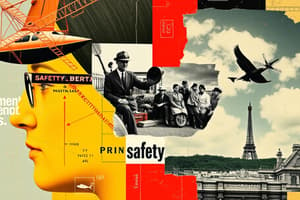Podcast
Questions and Answers
What factor is NOT considered in determining risk severity in a risk matrix?
What factor is NOT considered in determining risk severity in a risk matrix?
- Severity of consequences
- Risk control measures
- Likely occurrence
- External funding sources (correct)
What is one of the main controls in managing risk relevant to hospitality and tourism?
What is one of the main controls in managing risk relevant to hospitality and tourism?
- Reducing service delivery
- Increasing marketing efforts
- Extensive training in food safety (correct)
- Higher room rates
What is the purpose of risk monitoring?
What is the purpose of risk monitoring?
- To increase service prices
- To audit financial reports
- To assess and improve future management plans (correct)
- To eliminate all potential risks
Which of the following is NOT a step in risk control?
Which of the following is NOT a step in risk control?
Risk reassessment includes which of the following activities?
Risk reassessment includes which of the following activities?
What aspect of risk management focuses on examining and documenting the effectiveness of responses?
What aspect of risk management focuses on examining and documenting the effectiveness of responses?
What is the primary goal of risk management?
What is the primary goal of risk management?
Which of the following is a technique for risk monitoring?
Which of the following is a technique for risk monitoring?
What is a common misconception about the consequences of risk?
What is a common misconception about the consequences of risk?
Which of the following is NOT considered a source of risk?
Which of the following is NOT considered a source of risk?
In the risk management process, what is the purpose of the 'assessment' phase?
In the risk management process, what is the purpose of the 'assessment' phase?
Which of the following encompasses the evaluation of threats to human life and property in risk management?
Which of the following encompasses the evaluation of threats to human life and property in risk management?
What does effective risk management aim to prevent?
What does effective risk management aim to prevent?
Which of the following best defines 'risk' in the context of risk management?
Which of the following best defines 'risk' in the context of risk management?
What aspect of risk management can help in the decision-making process?
What aspect of risk management can help in the decision-making process?
Which step follows risk evaluation in the risk management process?
Which step follows risk evaluation in the risk management process?
What is the primary purpose of risk evaluation?
What is the primary purpose of risk evaluation?
Which of the following describes risk avoidance?
Which of the following describes risk avoidance?
What role does feedbacking and meetings play in risk management?
What role does feedbacking and meetings play in risk management?
Which action is NOT a part of risk mitigation?
Which action is NOT a part of risk mitigation?
In risk sharing and transfer, which entity is typically involved?
In risk sharing and transfer, which entity is typically involved?
What is the last resort when it comes to managing risks?
What is the last resort when it comes to managing risks?
Which of the following best represents risk sharing?
Which of the following best represents risk sharing?
What is the significance of evaluating weak areas in a risk management plan?
What is the significance of evaluating weak areas in a risk management plan?
What is the primary task assigned to the newly employed nurse's assistant?
What is the primary task assigned to the newly employed nurse's assistant?
What procedure do nurses follow after washing the trays and instruments?
What procedure do nurses follow after washing the trays and instruments?
What has contributed to the increase in the number of operations carried out by the hospital?
What has contributed to the increase in the number of operations carried out by the hospital?
What safety hazard is commonly associated with the washing area where nurses work?
What safety hazard is commonly associated with the washing area where nurses work?
Which component is NOT a part of the risk management process as outlined in the content?
Which component is NOT a part of the risk management process as outlined in the content?
How are the surgical instruments transported after they are sterilised?
How are the surgical instruments transported after they are sterilised?
What issue has the hospital faced that prompted changes in procedures?
What issue has the hospital faced that prompted changes in procedures?
What is a required task performed by nurses before sterilising theatre trays?
What is a required task performed by nurses before sterilising theatre trays?
Flashcards
Risk Management
Risk Management
The process of identifying, assessing, and controlling threats to an organization's capital and earnings.
Sources of Risks
Sources of Risks
Financial uncertainty, legal liabilities, strategic management errors, accidents, and natural disasters can all be risks.
Risk Management Process
Risk Management Process
The process of making and carrying out decisions to minimize the negative impact of risk on an organization.
Risk
Risk
Signup and view all the flashcards
Identify Risks
Identify Risks
Signup and view all the flashcards
Evaluate Risks
Evaluate Risks
Signup and view all the flashcards
Control Risks
Control Risks
Signup and view all the flashcards
Monitor Risks
Monitor Risks
Signup and view all the flashcards
Risk Matrix
Risk Matrix
Signup and view all the flashcards
Controlling Risk
Controlling Risk
Signup and view all the flashcards
Risk Monitoring
Risk Monitoring
Signup and view all the flashcards
Risk Reassessment
Risk Reassessment
Signup and view all the flashcards
Risk Audits
Risk Audits
Signup and view all the flashcards
Variance and Trend Analysis
Variance and Trend Analysis
Signup and view all the flashcards
Risk Identification
Risk Identification
Signup and view all the flashcards
Risk Assessment
Risk Assessment
Signup and view all the flashcards
Performance Evaluation
Performance Evaluation
Signup and view all the flashcards
Reserve Analysis
Reserve Analysis
Signup and view all the flashcards
Feedbacking & Meetings
Feedbacking & Meetings
Signup and view all the flashcards
Evaluation
Evaluation
Signup and view all the flashcards
Risk Evaluation
Risk Evaluation
Signup and view all the flashcards
Risk Avoidance
Risk Avoidance
Signup and view all the flashcards
Risk Mitigation
Risk Mitigation
Signup and view all the flashcards
Assess Risk
Assess Risk
Signup and view all the flashcards
What is Not Acceptable
What is Not Acceptable
Signup and view all the flashcards
Study Notes
Risk Management Overview
- Risk management is the process of identifying, assessing, and controlling threats to an organization's capital and earnings.
- These threats can stem from various sources, including financial uncertainty, legal liabilities, strategic errors, accidents, and natural disasters.
- The aim of risk management is to minimize the adverse effects of risk on the organization.
- Risk is defined as a situation involving exposure to danger.
Risk Management Process
- The risk management process involves several key steps: Identify, Assess, Evaluate, Control, and Monitor.
- Identifying potential risks that endanger human life, property, and food safety is crucial. Enterprise standards and legislation related to protecting lives and property must be applied. This isn't limited to customers, but also includes personnel, stakeholders, visitors and the wider public. Injuring anyone or losing property can be a threat.
- Assessing risks involves determining potential impacts (e.g., injury, illness, loss of property) and the likelihood of each risk occurring.
- Evaluating involves examining whether the identified risks are significant and if they can affect the organization's overall objectives.
- Controlling risks involves implementing strategies to mitigate risk. This could include actions like reducing the consequence of risk, making areas safer, and implementing better procedures. Correcting weak points and threats is critical.
- Monitoring risks involves tracking and reviewing risk levels, and re-evaluating them periodically to determine if new risks are emerging or if existing risks have intensified.
Risk Assessment
- Risk assessment is a crucial aspect of risk management. It involves analyzing the likelihood of an event, and the severity of the consequences, to quantitatively measure risks within an organization.
- Determining possible impacts like injuries, sickness, loss of property, or death is common in risk assessment.
- A risk matrix, often a 5x5 matrix, lists likelihood of occurrences on one axis and severity of consequences on the other axis.
- The example matrix provided demonstrates how to assess risk based on likelihood and severity.
- Qualitative data, like observing and analyzing risk, is used to determine the risk level.
Risk Matrix Example
- A 5x5 matrix assesses risk levels, relating likelihood and consequence.
- Likelihood categories (Rare, Unlikely, Possible, Likely, Almost Certain) are paired with consequence categories (Insignificant through Extreme).
- The intersection of these categories defines a risk level.
Controlling Risk
- Controlling risk involves actions to reduce likelihood and the consequence of risks through various strategies.
- Control methods include improving workplace hygiene, implementing proper food safety procedures, and ensuring equipment is functional, as well as preventing or minimizing accidents and disasters.
- Additional security measures and training are needed in risk control.
- Regular risk assessments and reviews are important to stay apprised of new developments and threats.
Risk Monitoring
- Risk monitoring is essential for continually tracking the effectiveness of risk management plans.
- This ongoing monitoring improves current and future management by continually assessing progress, outcomes, and impacts of risk management programs.
- It involves keeping track of identified risks, residual risks, and new risks.
Risk Reassessment
- Risk reassessment involves reviewing identified risks and the effectiveness of risk response plans.
- Organizations should scrutinize the identified weaknesses and strengths associated with threats and capitalize on the strengths and positive outcomes.
- Prioritization of risks is important to focus on those with high impact and likelihood first.
- Tools like audits, variance analysis, and trends analysis are used during risk reassessment, and reserve analysis to evaluate the contingency measures.
- Feedback mechanisms and regular meetings support ongoing risk management.
Evaluating Risk
- Evaluation of a risk plan's relevance, effectiveness, efficiency, and impact, is crucial.
- Risk evaluation should be compared with pre-defined goals, and a thorough examination of potential problems during implementation is essential.
- Risk mitigation, avoidance, transfer, and acceptance are various methods for dealing with risks in an organization depending on various factors.
Case Study: Hospital Sterile Supply Department (CSSD)
- The case study details the scenario of a hospital CSSD, listing hazards like unsafe floor conditions, bending concerns, and limited staff.
Activity #2 (Picture Analysis):
- Apply risk management to the pictured scenario (e.g., motorcycle transporting pigs).
- Use the process - identify, assess, evaluate, monitor, and control.
Activity #3 (What is NOT Acceptable):
- Use a 5x5 risk matrix to determine risks that are not acceptable/not worth considering.
Studying That Suits You
Use AI to generate personalized quizzes and flashcards to suit your learning preferences.


